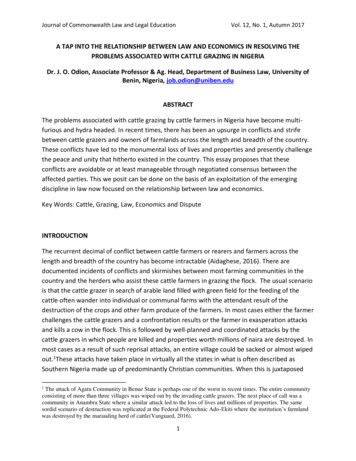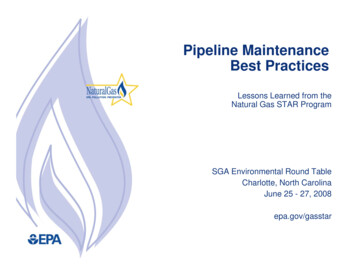
Transcription
Journal of Commonwealth Law and Legal EducationVol. 12, No. 1, Autumn 2017A TAP INTO THE RELATIONSHIP BETWEEN LAW AND ECONOMICS IN RESOLVING THEPROBLEMS ASSOCIATED WITH CATTLE GRAZING IN NIGERIADr. J. O. Odion, Associate Professor & Ag. Head, Department of Business Law, University ofBenin, Nigeria, job.odion@uniben.eduABSTRACTThe problems associated with cattle grazing by cattle farmers in Nigeria have become multifurious and hydra headed. In recent times, there has been an upsurge in conflicts and strifebetween cattle grazers and owners of farmlands across the length and breadth of the country.These conflicts have led to the monumental loss of lives and properties and presently challengethe peace and unity that hitherto existed in the country. This essay proposes that theseconflicts are avoidable or at least manageable through negotiated consensus between theaffected parties. This we posit can be done on the basis of an exploitation of the emergingdiscipline in law now focused on the relationship between law and economics.Key Words: Cattle, Grazing, Law, Economics and DisputeINTRODUCTIONThe recurrent decimal of conflict between cattle farmers or rearers and farmers across thelength and breadth of the country has become intractable (Aidaghese, 2016). There aredocumented incidents of conflicts and skirmishes between most farming communities in thecountry and the herders who assist these cattle farmers in grazing the flock. The usual scenariois that the cattle grazer in search of arable land filled with green field for the feeding of thecattle often wander into individual or communal farms with the attendant result of thedestruction of the crops and other farm produce of the farmers. In most cases either the farmerchallenges the cattle grazers and a confrontation results or the farmer in exasperation attacksand kills a cow in the flock. This is followed by well-planned and coordinated attacks by thecattle grazers in which people are killed and properties worth millions of naira are destroyed. Inmost cases as a result of such reprisal attacks, an entire village could be sacked or almost wipedout.1These attacks have taken place in virtually all the states in what is often described asSouthern Nigeria made up of predominantly Christian communities. When this is juxtaposed1The attack of Agatu Community in Benue State is perhaps one of the worst in recent times. The entire communityconsisting of more than three villages was wiped out by the invading cattle grazers. The next place of call was acommunity in Anambra State where a similar attack led to the loss of lives and millions of properties. The samesordid scenario of destruction was replicated at the Federal Polytechnic Ado-Ekiti where the institution’s farmlandwas destroyed by the marauding herd of cattle(Vanguard, 2016).1
Journal of Commonwealth Law and Legal EducationVol. 12, No. 1, Autumn 2017with the fact that most of the cattle grazers in the country are of the Fulani extraction inNorthern Nigeria, who are largely Muslims, then it is apparent that these skirmishes have thepotential for precipitating inter-tribal, inter-religious as well as regional conflicts and possiblywars that could threaten the peace and tranquillity in the country and ultimately thesovereignty and corporate existence of all the nationalities and religions that make up thecountry.2Incidentally, the tribal and religious coloration to this seeming economic conflict is not helpedby the decades of mistrust and suspicion between these two sides of the divide which is largelyinfluenced by regional or ethnic considerations. This mutual suspicion is even more now, giventhe fact that the current president of the country is from the Northern region of the countryand is often perceived as sympathetic to these cattle grazers. In the same vein, there arerumors that the frequency and intensity of these attacks by the cattle grazers is influenced bythe feeling and display of impunity by the cattle grazers, palpably because their “man” is at thehelm of affairs in the country (Aidaghese 2016)Strangely, very few have paused for a while to consider the fact that the cattle grazer and thefarmer are both engaged in farming, the all-important sector that is now key to economicsurvival in view of the dwindling fortunes in the oil sector, the country’s mainstay).In the samevein, not many people realize that both parties are businessmen whose modus operandi is toinvest in their separate genre of farming for the purposes of making a profit.It is even more revealing that in the concerted attempts to resolve these conflicts and probablyresolve the problem at hand, the approach of policy makers and the legislature in the country,both state and federal, has been to engineer policies or make laws that would make it possiblefor farm ranches to be established specifically for cattle grazing in the respective states. 3Whereas some states in the North readily latched at the prospect of establishing these cattleranches, most states in the South are antithetical to the idea.4 This is even more disturbing inview of the fact that the policy of the federal government as epitomized by the Minister of2On the 8th of October 2015 Elders of the South-West Region in reaction to the kidnap of their foremost leader andpolitician, Chief Olu Falae, threatened to banish all Fulani herders from their communities. In reaction Alhaji RabiuKwankwaso a former Governor of Kano State asked these leaders of the South-West to “shut up” See the (Punch,2015).3Some states of Northern Nigeria, e,g Niger and Kano States have commenced the process of acquiring largeexpanse of land in the state for cattle grazing purpose. There is presently the National Grazing Bill before theNational Assembly for the purposes of enabling the Federal Government to acquire lands in the states of thefederation for cattle grazing purposes.4Presently Ekiti State Government has just passed the Anti-Cattle Grazing Law. It criminalizes cattle grazing on unauthorized places and imposes penalty on defaulters (Vanguard, 2016).2
Journal of Commonwealth Law and Legal EducationVol. 12, No. 1, Autumn 2017Agriculture is to establish these ranches and import special green grasses to be cultivated forthe purposes on establishing and sustaining these ranches.5Therefore, consistent with government’s interventions through direct regulation through policythrusts and law, the persuasive and negotiating powers of the affected parties, i.e., the cattlegrazer and the farmer to come together and agree on the best way to do their business devoidof economic losses and the devastating effects of the resulting conflicts outlined earlier is oftenignored.6 As is often the case, the state subrogates itself to the rights of these parties andattempts to fix a deal for them without a whiff about their impute. This is because there is apresumption of freedom of contract between the parties , therefore the resolution of anyconflict between the parties ought to be done within the confines of the terms and conditionsof the contract.This is why it has become necessary to propose that the State avoids getting involved in a directregulation of the business relationship between the cattle grazer and the farmer. It will bedemonstrated that a better approach is that based on an indirect regulation which focuses onharnessing the positives from a relationship between law and economics. It will be argued thatthe state instead of prescribing laws that prohibit or criminalize open cattle grazing or thefarmer and the cattle grazers getting involved in endless litigation, both of them can negotiateand arrive at a reasonable compromise.CIRCUMSCRIBINGTHE RELATIONSHIP BETWEEN LAW AND ECONOMICSThe relationship between law and economics has attracted a lot of attention in recent times.This is because there is a lot of benefit to be derived from a convergence of law and economicsin the resolution of the problems confronting the world (Emiri, 2013). Most advocates of therelationship between law and economics justify their push on the basis that in the distributionof the scarce economic resources available, law plays a pivotal role in striking a balancebetween the competing ends (Leary, 2005). They also argue that in the resolution of the conflictof interest between state intervention in business and contractual obligations economicconsiderations ought to play a leading role (Posner, 1983; see also Coase, 1960; Calabresi, 1961and Markovits, 1998).As a starter, the term “law and economics” is used to circumscribe the relationship betweenlaw and economics, where economic values pre-supposedly plays a domineering role. In this5The Minister of Agriculture gave this hint at the end of the Federal Executive Council meeting of 1 st March 2016.As a matter of fact the push for the importation of this special grass is causing ripples in the polity (Punch, 2016).6There has been this debate as to whether the Government should directly regulate private business or it shouldadopt a more flexible indirect regulatory measure (Posner, 1992, p.151).3
Journal of Commonwealth Law and Legal EducationVol. 12, No. 1, Autumn 2017symbiotic relationship the method of economics is used to rationalize legal problems and viceversa (Friedman, 1987). This is because, as shall be revealed soon, the efficiency of a law ismeasured in the economic terms by the limited financial implications of its enforcement. A lawis also measured by the level of equilibrium it strikes between the citizenry in the allocation ofresources. Accordingly, a law is efficacious if does not cost the state so much to enforce. In thisregard, tax laws are deemed efficacious only if the return from their strict enforcement is theincrease of government revenue through increased payments. Whereas laws that are enactedto regulate business undertakings by individuals and corporations may be regarded asineffective if so much of the tax payers monies are expended in enforcing them without gettingthe commensurate financial benefits (Cooter and Ulen, 2016, p.2).On the other hand, the law isrelevant in the streamlining of economic policies of countries to ensure that they are gearedtowards the overall benefit of the citizenry. In practical terms, law is a useful tool in theregulation of business and other commercial undertakings in order to ensure that the rights ofthe parties thereunder are protected. Accordingly, because of this overlap between legalsystems and political systems some of the contending issues are often resolved on the basis ofstudies in political economy and constitutional economy as well as political science. Thepractical effect of such considerations are often felt when laws are enforced and the desiredresults are not attained. Often, lawyers ask, “How will a sanction affect behaviour?” Forexample, if punitive damages are imposed upon the maker of a defective product, what willhappen to the safety and price of the product in future? Accordingly, the impact of law on theeconomic and political policies of a country becomes a central issue (Cooter and Ulen, 2016,p.3).Historically, study in law and economics is traced to Adam Smith, who as early as theeighteenth century discussed the economic effect of Mercantile Legislation. However, the morein-depth analyses involving the use of principles of economics to regulate non-market activitiesare traceable to the works of the leading lights like Coase (1960) and Calabresi (1961).There are two schools of thought on the relationship between law and economics. These arethe positive law and economics school as well as the normative law and economics school(Calabresi, 1972). Positive law uses economic analysis to predict the effects of the various legalrules. The positive theorist believes that common law, that is case law, is sufficient so long as itrecognizes the relevance of market forces in its enforcement. They urge that the legal systemshould as much as possible force transactions into a market model (Emiri, 2013; see also Rubin,1977; Epstein, 1982). In effect, this school of thought believes that the efficacy of law isdetermined by the economic benefits derivable from it. Accordingly, a positive economicanalysis of tort law would predict the effects of strict liability rule as opposed to the effect ofthe rule of negligence (Attanasio, 1988). The dividing line is that whereas strict liability isimposed to reduce the burden of proof placed on a consumer plaintiff in a product liability suit,4
Journal of Commonwealth Law and Legal EducationVol. 12, No. 1, Autumn 2017a positive economist view point is that the error or mistake complained about is part and parcelof the business for which blameworthiness need not be ascribed to anybody (Shadwell, 1987,p.235).This explains the initial reluctance by the courts, even in Europe, to impute a strictliability standard in product liability law. The reason was that such a high standard woulddiscourage enterprise and in the long run lead to economic losses for the state. In the words ofGrubb:There is a divide between those who believe negligence provides thebest balancing mechanism and those who feel strict liability providesbetter incentives for producers to prevent harm and better internalizesthe cost of the activity. (Grubb, 2000, p.18)However, on the part of the normative school of thought, they argue that there is the need togo beyond the economic cost, but to look into the long term economic consequences of variousgovernmental policies and laws. They believe that efficiency is a desirable goal that the lawought to pursue. Whereas, the Normative school of thought emphasize the “ought”requirement in expected efficacy of the law, the Positive school of thought argue that everyeffort should be made to make a law effective even if it involves infractions on the rights ofothers. In their view, it is primarily the interest of economic scholars concerned about legalreforms to canvass for an “ought to” position in this regard.7 The emphasis is on the economicanalysis of efficiency, more often expressed as allocative efficiency.8 It is furtherance of theaforesaid, that the pareto efficiency concept in the analysis of the economic efficiency of legalrules was propounded. In the opinion of proponents of this concept, a legal rule is efficient if itcould not be changed so as to make one person better off without making another worse off.Veritable examples in this regard are some of the proposed anti-grazing laws in Nigeria. Suchlaws if enacted and enforced in the manner they were conceived originally , it would mean thedisplacement of some persons engaged in a type of farming (Cattle grazing) for the benefit ofanother farmer (Crop farmer).9This was certainly a ground breaking concept with far reachingimplications for product liability law and in the long basis for consumer protection.Fundamentally, it underscores the basis for the state evolving protectionist laws in favour of theconsumer as against the manufacturers and suppliers of goods and services. To what extentwould consumer protection laws be assessed as efficient in the protection of the consumer?Will it be better to protect the consumers who are more in number than to consider theeconomic interest of few manufacturers? What should be the basis of ascertaining the5
Journal of Commonwealth Law and Legal EducationVol. 12, No. 1, Autumn 2017efficiency of the institutions put in place for the articulation and protection of consumer rights?Whilst, a pareto efficiency,analysis, would determine the efficiency of consumer laws andinstitutions put in place for its enforcement on this narrow confines.10It has been criticized asnot totally reflective of the indices for ascertaining efficiency of public institutions.11One of the criticisms often labeled against the pareto efficiency concept and by extensionnormative economics is that the use of the concept in economic analysis is so abstract andclassical that it often undermine human rights and the concerns for distributive justice.12 It isargued that it concentrates so much on the economic variables that the basic rights of theindividual that the law is aimed at protecting is ignored. Accordingly, in the context of consumerprotection, economic considerations cannot be placed in the front burner far and above thebasic rights of the consumer. Whatever, economic considerations to be examined should be inthe context of protecting the economic interest of the consumer as well as ensuring that lesspublic funds are wasted in that regard. It is in the light of the aforesaid that it has been arguedthat the assumed benefits of law and policy should now be assessed on the theory of secondbest The proposal is that, “if the fulfilment of subset ofoptimal conditions cannot be met underany circumstances, it is incorrect to conclude that the fulfilment of any subsequent subset ofoptimal conditions will necessarily result in an increase in allocative efficiency”13 Accordingly,any expression of public policy, whose desired purpose is undefined in area of allocativeefficiency, is viewed with suspicion. Thus, otherwise economic concepts like mergers andacquisition have been viewed from that perspective. The relevance of law and economics can beappreciated even without focusing on the division between the normative school of economicsand the positive school.A PEEP INTO THE COESEAN THEORY AS A PARADIGM OF THE RELATIONSHIP6
Journal of Commonwealth Law and Legal EducationVol. 12, No. 1, Autumn 2017Ronald Coase was one of the primogeniture of the relationship between law and economics. Itwas his view that economic parameters could be used to resolve complex legal problems withmaximum effect. Coase (1960) in his in depth analysis of the problem associated with the costof enforcing state sponsored regulatory measures in business, opined that business peopleshould be given the leverage to negotiate and settle their way out of problems associated withthe production and distribution of their goods or services. In his view, the risk of injury ordamage to a potential buyer or consumer of goods is a transaction cost which should be builtinto the cost of production by the business person, albeit a manufacturer. Accordingly, wherethe transaction cost is insignificant when compared to the expected profit from the business,then the risk is worth it, as such a risk can be effectively taken care of by the marketmechanism. His analogy of the farmer and their farm, the meat supplier and their cows wasinstructive. It is his argument that instead of litigation between the farmer and the meatsupplier over the destruction of the former’s crops by the latter’s cows, a negotiatedsettlement that would factor that risk into the cost of production by the farmer and the sellerwill be less expensive and more effective. A negotiated settlement in this context could involveboth parties either deciding amongst themselves who should build the wall around the farm or,amongst themselves, who should undertake the expenses of doing so. The argument by theproponents of the synergy between these two disciplines is that it is better and more pragmaticfor the business people themselves to fix the cost of redressing this extra cost of doing theirbusiness than for the courts to do so for them. Becker in his classic analysis also cited thefollowing example: Eddie’s Electric Company emits smoke that dirties the washing hangers atLucille’s Laundry. Eddie’s can completely abate the pollution by installing scrubbers on itsstacks, and Lucille’s can completely exclude the smoke by installing filters on its ventilationsystem. Installing filters is cheaper than installing scrubbers. No one else is affected by thispollution because Eddie’s and Lucille’s are near to each other and far from anyone else. Lucille’sinitiates court proceedings to have Eddie’s declared to be a “nuisance.” If the action succeeds,the court will order Eddie’s to abate its pollution. Otherwise, the court will not intervene in thedispute. What is the appropriate resolution of this dispute? (Cooter and Ulen, 2016, p.5). As itwas resolved between the farmer and the owners of the cows, since it is cheaper for Lucille toinstall the filters to protect her clothes from the effect of Eddies’ pollution, an efficientintervention of the law ought to be one that would encourage her to install the filters ratherthan compelling Eddie to install the scrubbers on its rack. This is because ultimately the burdenof the extra cost of installing it will be passed on to the ultimate consumer by way of increasedprices (Cooter and Ulen, 2016, p.5 Calabresi (1961, p.275) points out that the costs of anaccident include(a) the cost of preventing the accident; (b)the cost of the harm done to thevictim; and (c) the transaction cost of enforcing the law to redress the harm. In his view, wherethe cost of preventing an accident will outweigh the cost of redressing the injury resulting fromthe injury, it is more financially prudent to treat the accident as part of the production process.7
Journal of Commonwealth Law and Legal EducationVol. 12, No. 1, Autumn 2017This is because, from an economic point of view, the manufacturer should factor in thelikelihood of paying compensation for injuries arising from its errors in the production processas part of its cost of production. Accordingly, they should be prepared to pay for such anaccident without waiting for the law to intervene or going through the rigours of litigation.However, the Coasean theory is premised on an assumption of a perfect market situation. Thishas been criticized as in practice, there is no perfect market (Breyer, 1982, p.32). Players in themarket are often tempted to manipulate the market to suit their peculiar goals. The distortionin the interplay of market forces can be understood from two perspectives. First, the consumeris assumed to be a rational and careful person who can readily make informed choices. This isfar from the truth as most consumers are ignorant, gullible and at times often blinded by hasteand sheer desires, that they often make the wrong choices (Cranston, 1984, pp.23-28).Second,there is the assumption that businessmen will compete freely and fairly for the patronage ofconsumers. However, in practice there is a lot of business stratagem used by business to out foxtheir rivals as well as entrap the consumer. These business antics include advertisements, salespromotions, price fixing and syndicating amongst others. For example, through advertisementmanufacturers distort the information about the goods and services offered to the consumer,thus ultimately denying him the much needed information to make informed choices (Cranston,1984, p.24).This is where competition law will come into play to address these incidences of marketimperfection and failure. Competition policy and law will work in the area of laying the blueprint for manufacturers and producers of goods and services to compete freely and attractpatronage from the consumer. In this regard, monopolies or the dominant position ofcompanies or other business organizations are outlawed. Competition law is essentiallyanchored on a free market system (Taylor; Cambridge, 2006). The goals of competitionlegislation include the following: The encouragement of free and open markets, the provision offair and equal competitive opportunities to all market participants, the promotion of allocativeefficiency, the maximization of consumer welfare and the establishment of transparency andfairness in the regulatory process (Dimgba,2016 ). In driving home, these set objectives,competition is expected to create four distinguishable parameters for measuring efficiency inthe market place, the productive efficiency which is aimed at ensuring that goods and servicesare produced at minimal cost, allocative efficiency which ensures that available resources areused efficiently, dynamic efficiency encourages firms to be innovative in their productionmethods to reduce production risks and cost, inter-temporal efficiency which emphasizes theutilization of available resources for the long term benefits of the citizenry (Dimgba,2016 ).THE COASEAN THEORY AND THE RESOLUTION OF THE CONFLICT8
Journal of Commonwealth Law and Legal EducationVol. 12, No. 1, Autumn 2017It is apparent from the foregoing that, just as Coase had decades ago proposed that the farmerand the cattle rancher could come together and negotiate a resolution of the conflict of interestarising from the latter’s cows coming to destroy the former’s crops, it is not out of place forfarmers in Nigeria and their cattle grazers to come to such peaceable resolution without theresort to violence and the resultant loss of lives and properties.In practical terms, the cattle grazer should see the likelihood of his flock straying into thefarmer’s farm and destroying his crops as a transaction cost that must be borne by thebusiness. He could either chose the option of constant payment of agreed compensation forthe quantum of crops destroyed by his cattle or he could negotiate with the farmer to acquirethe farm ostensibly for feeding his cattle. Since the farmer is in the business of farming forprofit purpose, it is possible that he could give up his farm and relocate elsewhere if the price isgood. Conversely, the farmer could negotiate with the cattle grazer to acquire his flock as partof his farm, in which case he ceases to see the cattle as the enemy destroying his farm nutrather as part of his farm. What follows may be the likelihood of the farmer ceding a part of hisfarm for the purposes of feeding his cows whilst maintaining the other portion as his farm forhis crops. A high fence that will prevent the cows from straying into the crop farm is apossibility though, as imperfect as the coasean theory is, this burden of expenses on the farmmay be passed on to the buyer in the form of high costs for the farm produceSimilarly, owners of vast expanse of yet to be cultivated land can, subject to negotiations andproper pricing, cede the same to the owners and cattle herders for their cattle grazingpurposes. In this way, communities and individuals alike can maximize the economic benefits ofthe business and live together in peace and harmony.This is where government intervention becomes veritable. Through a policy thrust anchored onsubsidy, government at whatever level could subsidize the expenses of either party, i.e., thefarmer or the cattle grazer so that the economic cost of resolving their differences will bemitigated and ultimately there will be no basis to pass the buck to the hapless consumers.14Government need not intervene directly by churning out laws to either prohibit of permittinggrazing. There already exist in our criminal laws abundant provisions dealing with the recklessor negligent use of animals to either disturb public peace and order or to cause nuisance tomembers of the public.15 As observed earlier, the relevance of competition law in this context isbest appreciated from the angle that the farmer and the owner of the cows will not suffer thedisadvantage of direct government intervention in their business with the attendant nuances ofover-regulation which often stifle business. Since they are both involved in the business of14This is what is recommended to the states in the Northern Region of the country that are focused on acquiring andfunding grazing fields for cattle rearing.15In Edo State of Nigeria, sections 7-10 of the Animal (Disease) Law Criminal Code Cap 8 Laws of Bendel State ofNigeria, make elaborate provisions for the safe and sanitary transportation of cattle in the State.9
Journal of Commonwealth Law and Legal EducationVol. 12, No. 1, Autumn 2017farming, albeit different types of farming, what is expected is that indirect regulation by way ofpreventing underhand dealings or sharp business practices amongst them ought to be theemphasis of any legislation. One of these two shades of farming business should not be allowedto dominate or subrogate the other, they can co-exist. This is best achieved through anegotiated settlement. As noted earlier, direct regulations in the manner of fines and penaltieswould only end up driving the prices of the goods in question upward. Accordingly, if the ownerof the cows is forced to build the wall when it is more expensive for them to do that comparedto the farmer, then the owner would try to reduce their “transaction cost’ by passing same tothe ultimate consumer (Cayne and Trebilock, 1973, p.396).CONCLUSIONThe author has in the course of this essay examined the possibility of a private and contractualresolution of the conflict between owners of farmlands and the owners of cows with respect tothe cattle grazing in the country. It is the author’s view that the problem has becomeintractable, volatile and now threatens peace, tranquillity and the sovereignty of this country.Government has done well to intervene in order to stop the tide of the violence and theconsequences that has resulted from the conflict between these set of “farmers”. However, theauthor’s treatise is that the Government need not intervene through direct and prescriptivelegislation as it is trying to do presently through the proposed National GrazingLaw.16Government cannot effectively use this piece of legislation to force communities or stateto donate or cede their farmlands to the cattle herders for grazing period. As a matter of factGovernment ought not to be directly involved in the acquisition, setting up of grazing lands orthe importation of the so-called special grass for feeding the cattle.The author has argued that the crop farmer and the cattle herders are both farmers andbusiness people who are in it for profit. All that government needs to do is to provide theenabling environment through proactive policies anchored on agricultural subsidies to makethe cost of these two vital categories of farming less expensive
PROBLEMS ASSOCIATED WITH CATTLE GRAZING IN NIGERIA Dr. J. O. Odion, Associate Professor & Ag. Head, Department of Business Law, University of Benin, Nigeria, job.odion@uniben.edu ABSTRACT The problems associated with cattle grazing by cattle farmers in Nigeria have become multi-furious and hydra headed.











